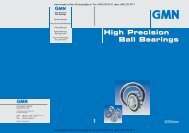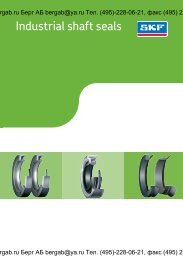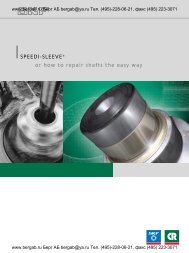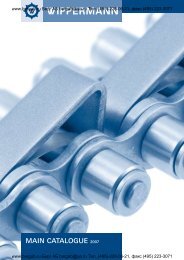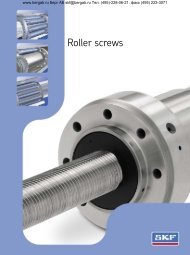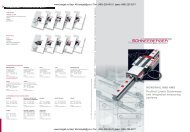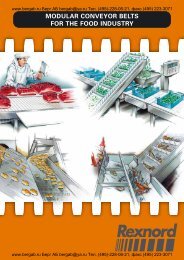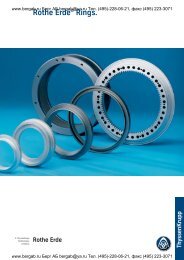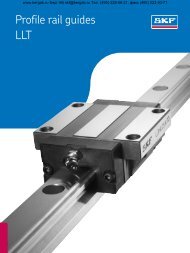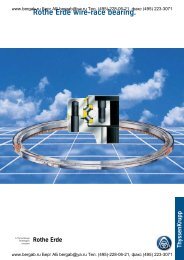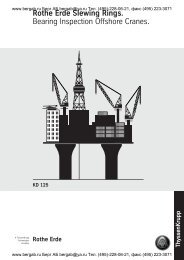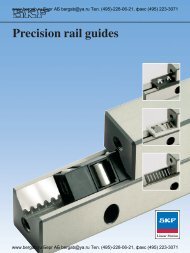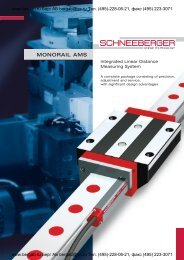Chains
Chains
Chains
Create successful ePaper yourself
Turn your PDF publications into a flip-book with our unique Google optimized e-Paper software.
Environmental<br />
Conditions<br />
www.bergab.ru Берг АБ bergab@ya.ru Тел. (495)-228-06-21, факс (495) 223-3071<br />
Assembly and installation<br />
Pull a short section of chain through the entire conveyor to detect any<br />
obstructions or areas of tight clearance. Check the conveyor for loose<br />
nuts, bolts and any projections.<br />
Ensure that the joints in the wear strips and the support elements are<br />
even, and that the clearance between chain and chain guides is correct.<br />
Welding metal splashes, metal chips and paint must be removed from<br />
the sliding surfaces.<br />
Check also the clearance between chain and guide rail. Ensure that<br />
sprockets and idler wheels are correctly aligned. ensure that the entire<br />
length of the chain is properly lubricated.<br />
CAUTION:<br />
Install chain in 3 metre sections, making all connections on the<br />
conveyor frame. Thread chain onto conveyor carefully to avoid<br />
twisting and possible damage to the chain.<br />
Inspection<br />
During day to day operation, the chain, sprockets and conveyor system<br />
must be regularly inspected. This prevents defects and allows repairs to<br />
be carried out before serious damage is caused. The cost of regular<br />
maintenance is more than paid for by the longer service life and the<br />
absence of breakdown in the functioning of the conveyor. In order that<br />
any adjustments can be carried out at once, additional checks should be<br />
carried out during the initial phase. When the preliminary phase is over,<br />
only routine inspections are necessary. A fixed inspection schedule<br />
should be drawn up:<br />
1) Are there any unusual grooves on the chain?<br />
2) Check that the surface of the chain is even.<br />
3) Check the clearance between the individual links and ensure<br />
that this has not increased as a result of overloading or<br />
blocking.<br />
4) Pulsating is a sign of insufficient lubrication or of catching by<br />
the chain.<br />
5) Check the clearance of deadplates and turntables.<br />
6) Do the sprockets show signs of excessive wear?<br />
7) Is dirt accumulating between sprocket teeth?<br />
8) Check for sprocket guide ring wear and chain misalignment.<br />
9) Check the ways and wear strips for excessive wear.<br />
10) Is the lubrication system working correctly?<br />
11) Check the insides of the corner wear strips and chain guidesexcessive<br />
heat may indicate tight clearance or high friction.<br />
12) Check return rollers for free rotation.<br />
Lubrication<br />
Special attention should be paid to lubrication. Ensure that there is<br />
sufficient lubricant on all areas of the chain and wear strip. Continuous<br />
lubrication or application of the lubricant at regular intervals should be<br />
provided. Continuous and even lubrication is especially important at the<br />
entry to a corner. If the conveyor cannot be lubricated during operation,<br />
this should be carried out when it is at a standstill. The service life is of<br />
sideflexing chains can be considerably increased by the application of<br />
light mineral oil to the sliding surfaces before assembly. in the case of<br />
sideflexing TableTop® chains, the roller chain should also be oiled before<br />
assembly.<br />
Some lubrication processes and materials are listed below.<br />
LUBRICATING AGENTS<br />
1) Oil Based Lubricant<br />
These are vegetable or mineral oils which have a high lubricity<br />
and coat chain parts which are subject to corrosion. If possible,<br />
lubricants of this type should be used for all metal chains.<br />
2) Synthetic lubricants<br />
Concentration is not depending on water hardness. Less foam on<br />
the conveyor, which makes inspection more easy. No slippery<br />
factory floors. Less bacteria growth.<br />
3) Soap besed lubricants<br />
Best possible lubrication because the lubrication sticks on the<br />
chains. Feels more greasy. High concentration is less critical.<br />
4) Water<br />
Although pure water is much less effective that the above types,<br />
pure water can also be used as a lubricant. In the case of plastic<br />
chains which run on stainless steel guides, this may increase the<br />
load on the chain since a thin film of water must constantly be<br />
sheared.<br />
METHODS OF LUBRICATION<br />
1) A central lubrication system pumps lubricant to the required<br />
locations.<br />
2) Sideflexing chains can be lubricated effectively by applying the<br />
lubricant at the entry to the curve directly between chain and<br />
wear strip.<br />
3) The return chain passes through a bath of lubricant<br />
4) The returning chain contacts wheels made of porous material<br />
which turn in a bath of lubricant.<br />
5) The lubricant drips on to the chain from a tank suspended above it.<br />
6) Water drips onto soap and then onto the chain.<br />
DRY RUNNING CONVEYORS<br />
In some positions in a bottling or canning line, running without<br />
lubrication is possible. Rexnord has experience with plastic chains in<br />
applications with no lubrication. Important aspects of running dry running<br />
conveyors are :<br />
+ Savings will be made on investments in lubrication system such<br />
as dosing equipment.<br />
+ Elimination of costs of lubricants, clean water and water<br />
treatment.<br />
+ Improvement of plant safety due to the elimination of slippery<br />
factory floors.<br />
+ No packaging damage cused by wet containers.<br />
+ Biological Oxygen Demand- reduction resulting in a more<br />
environment friendly production plant.<br />
– Coefficient of friction increases. Lubrication provides the best<br />
product handling.<br />
– Extra cleaning may be necessary, otherwise the coefficient of<br />
friction increases.<br />
– Extra wear on components like chains, wearstrips and drives.<br />
– Chance of slip stick effect under certain conditions.<br />
– Chance of built up of static electricity.<br />
– Higher noise level (sometimes a creaking sound running plastic<br />
chains in curves).<br />
– Not possible on high speed running conveyors.<br />
Note<br />
It is strongly recommended to clean dry running conveyors regularly. Dirt and<br />
debris must be removed by cleaning, in order to keep the friction coefficients<br />
between chains optimal.<br />
www.bergab.ru Берг АБ bergab@ya.ru Тел. 116 (495)-228-06-21, факс (495) 223-3071



